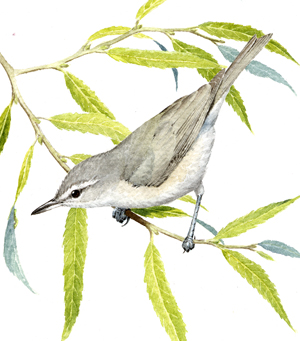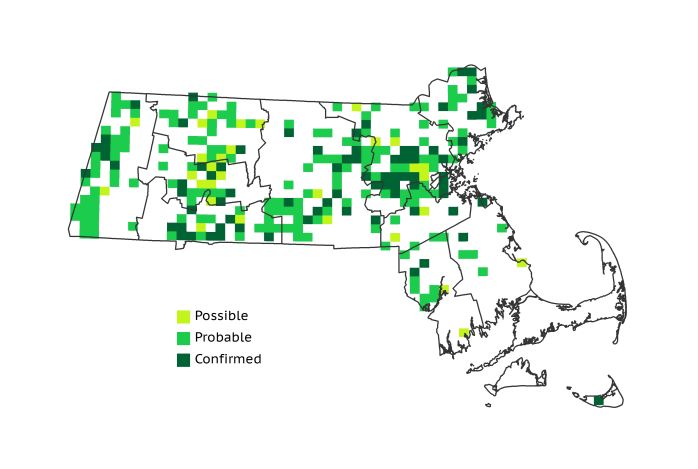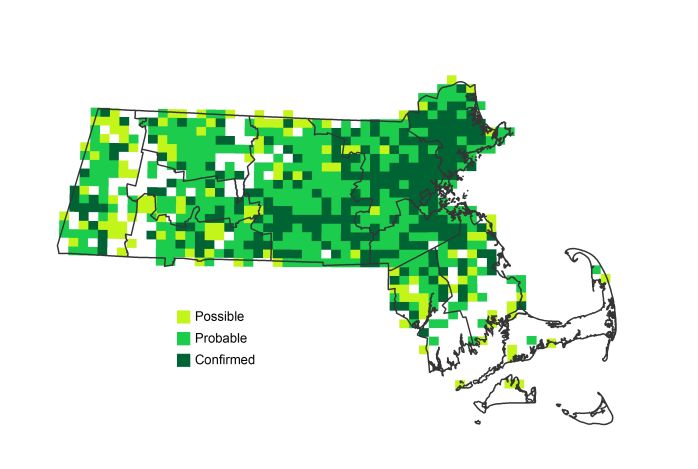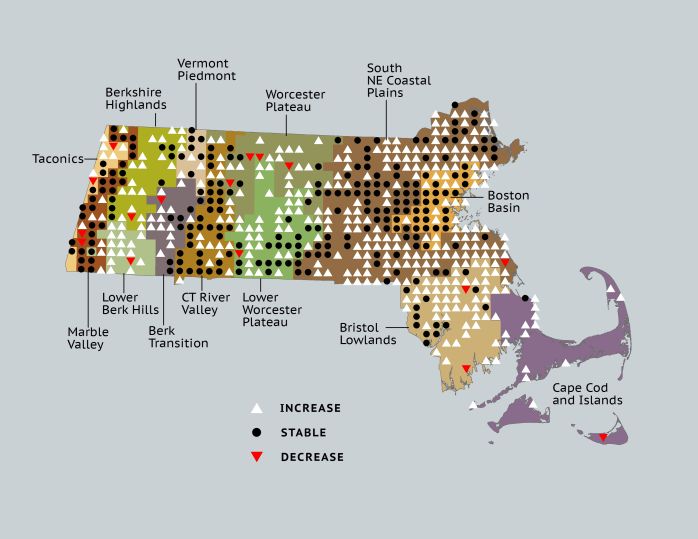Breeding Bird Atlases (BBA)
Find a Bird
Warbling Vireo
Vireo gilvus

Very widespread and strongly increasing
“I long for rural and domestic scene, for the warbling of birds and the prattling of my children.” – John Adams
Rural and domestic well describes the setting where Warbling Vireos were often encountered in days of old. The face of a Warbling Vireo is not one you would likely remember after meeting one on a country lane, however. Of all our breeding vireo species, the Warbling Vireo is the most drab and unassuming in appearance. It more than makes up for this, though, with its enthusiastic and melodious singing. Warbling Vireos can be heard throughout the breeding season in Massachusetts, and their breeding range within the state has expanded considerably since Atlas 1.
Historic Status
In the 1800s William Peabody described the song of the Warbling Vireo as “one of the chief attractions of a summer day” in Massachusetts (Peabody 1839). This applied to cities as well as towns and villages, since the Warbling Vireo often nested in the large shade trees that lined city streets, and the Boston Common was once known as a fertile breeding ground for the species (Bent 1948). But two forces conspired against the vireos' future success. First, the midnineteenth-century introduction of the House Sparrow helped to force this species out of the cities (Brewster 1906). Then, during the same era the onset of Dutch Elm disease and the destruction of many of the state's American Elms, a favored nesting tree of the species, may have contributed to the “great decreases” in Warbling Vireos pronounced by ornithologists Ludlow Griscom and Dorothy E. Snyder (Griscom & Snyder 1955).
Atlas 1 Distribution
The presence of Warbling Vireos in Atlas 1 was likely tied to the availability of riparian woodland habitat. Warbling Vireos gravitated toward the low, well-watered areas of the state, where deciduous trees grew in fertile river valleys. Warbling Vireos were present in 74% of Marble Valley blocks, and were also found in more than 50% of the Vermont Piedmont and the Connecticut River Valley. They were more local across the Worcester and Lower Worcester Plateaus, congregating around major river systems while shunning most other areas. The Coastal Plains had breeding Warbling Vireos in a third of all blocks, and breeding activity was recorded in 45% of the Boston Basin around the confluence of the Charles River and its tributaries. The vireos were quite local in the Bristol/Narragansett Lowlands and almost entirely absent from the Cape and Islands.
Atlas 2 Distribution and Change
By the time of Atlas 2, Warbling Vireos appeared dead set on reclaiming every acre of territory that they had ever occupied in the past. They made considerable inroads in higher regions where they were formerly rare or absent, with 19 new blocks occupied in the Berkshire Highlands and 14 in the Lower Berkshire Hills, when the best-surveyed blocks are compared. Smaller increases were recorded eastward through the Connecticut River Valley, and in the most well-surveyed blocks the mature forests of the Worcester and Lower Worcester Plateau welcomed Warbling Vireos into 50 previously unoccupied blocks between them. The Coastal Plains were veritably conquered by this expanding species, which appeared anew in 133 blocks, almost 60% of the region! The shady avenues of the Boston Basin were again awash with Warbling Vireo song as the bird nearly doubled its distribution in that well-settled area. The frontier of Warbling Vireo recolonization formed a line across the state from Plymouth Bay to Fall River in the Bristol/Narragansett Lowlands, where it also expanded. The species’ distribution remained quite local on the Cape and Islands, but nonetheless reflected signs of steady growth.
Atlas 1 Map

Atlas 2 Map

Atlas Change Map

Ecoregion Data
Atlas 1 | Atlas 2 | Change | ||||||
Ecoregion | # Blocks | % Blocks | % of Range | # Blocks | % Blocks | % of Range | Change in # Blocks | Change in % Blocks |
Taconic Mountains | 6 | 37.5 | 2.2 | 14 | 56.0 | 1.9 | 4 | 26.7 |
Marble Valleys/Housatonic Valley | 29 | 74.4 | 10.7 | 34 | 87.2 | 4.7 | 5 | 12.8 |
Berkshire Highlands | 9 | 16.4 | 3.3 | 30 | 54.5 | 4.1 | 19 | 35.8 |
Lower Berkshire Hills | 2 | 7.1 | 0.7 | 16 | 51.6 | 2.2 | 14 | 51.9 |
Vermont Piedmont | 9 | 52.9 | 3.3 | 16 | 94.1 | 2.2 | 4 | 33.3 |
Berkshire Transition | 9 | 23.7 | 3.3 | 27 | 67.5 | 3.7 | 12 | 38.7 |
Connecticut River Valley | 36 | 64.3 | 13.3 | 58 | 89.2 | 8.0 | 16 | 33.3 |
Worcester Plateau | 15 | 19.2 | 5.5 | 62 | 70.5 | 8.6 | 20 | 41.7 |
Lower Worcester Plateau | 23 | 31.1 | 8.5 | 71 | 88.8 | 9.8 | 30 | 55.6 |
S. New England Coastal Plains and Hills | 90 | 33.3 | 33.2 | 261 | 92.2 | 36.0 | 132 | 58.4 |
Boston Basin | 25 | 44.6 | 9.2 | 49 | 87.5 | 6.8 | 23 | 41.8 |
Bristol and Narragansett Lowlands | 16 | 15.1 | 5.9 | 68 | 59.6 | 9.4 | 46 | 45.5 |
Cape Cod and Islands | 2 | 1.5 | 0.7 | 19 | 13.2 | 2.6 | 15 | 12.5 |
Statewide Total | 271 | 28.0 | 100.0 | 725 | 69.9 | 100.0 | 340 | 41.0 |
Notes
In accordance with Atlas increases, the Warbling Vireo shows a significant increasing Breeding Bird Survey (BBS) trend in Massachusetts and in the New England/Mid-Atlantic Region. Curiously, the species shows a significant decreasing BBS trend in the Eastern US overall.



